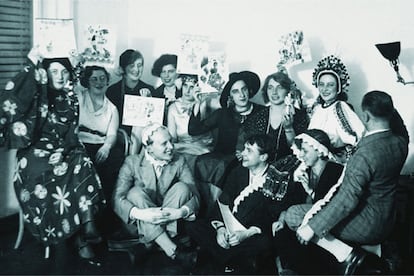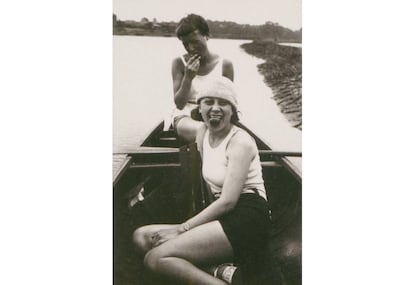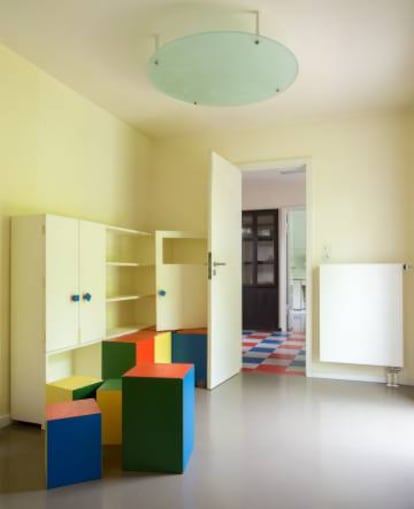The irrepressible rebirth of the Bauhaus women
Forgotten by history until the late 20th century, new publications celebrate the legendary design school’s alumnae

Maybe you’re reading this article under a flexo light, not realizing that the lamp with a flexible arm was invented by a Bauhaus student. You almost certainly don’t know that the student was a woman named Marianne Brandt. After the legendary German school of art, architecture, craftsmanship and design celebrated its centennial in 2019, the public slowly began learning about the long-overlooked role of women in that creative, utopian experiment wedged between the two world wars. It was not an insignificant role since around 50% of the students were female. Several reports and books were published about these Bauhaus women around the centennial. An exhibition was held, and a film (Bauhaus), a TV series (Bauhaus: A New Era) and a documentary (The Women of the Bauhaus) were released. Four years later, interest in these creative women forgotten by history hasn’t waned and more tributes continue to trickle in.
A recent novel by Spanish author Angélica Morales titled La casa de los hilos rotos (or The House of Broken Threads) fictionalizes the life of Otti Berger, an artist murdered in the Auschwitz death camp in 1944. Berger was in charge of the Bauhaus textile workshop during her time in Dessau (Germany) after the school moved there in 1925 from its Weimar birthplace. Born in 1919, the school’s last headquarters in Berlin were closed down by the Nazis in 1933. In 2022, author Dakota Hernández published Womanhaus, an illustrated book with a brief history of the Bauhaus school and biographies of some of its leading figures. In 2021, Marisa Vadillo, a professor at the University of Seville (Spain), published her third book based on her doctoral thesis on the women of the Bauhaus school. And in 2015, professor Josenia Hervás of the University of Alcalá (Spain), also published a book about these female artists based on her doctoral thesis.

With all the real-life stories about creative women in the very intense first half of the 20th century, it seems incredible that there is so little fiction about those pioneering women who helped shape avant-garde art. “It’s hard to believe that we’re still in that prehistorical period,” said Angélica Morales, who had to invent most of the details of Otti Berger’s life for her novel since so little personal information about her exists. “Her work has been patented, but very little information about her private life is known,” said Morales. “She was the first woman in Germany to patent a textile and also became famous outside Germany after receiving commissions in London and Switzerland. She appeared in news magazines and her paintings represented Croatia at the Paris Universal Exposition.” Besides being a female artist, Berger was a communist, Jewish and deaf, which makes it more remarkable that she became a Bauhaus teacher, albeit unofficially, says Morales. “But there are many other women, such as Gunta Stölzl [one of the three official Bauhaus professors along with Lilly Reich and Gertrud Grunow], who have several books written about them,” laughed Morales.
When Marisa Vadillo began her doctoral thesis in 2002, she assumed she’d maybe find “three girls” in the Bauhaus archives to study. “Imagine my surprise when I learned they [women] were almost half of the school’s students,” she said. With architect Walter Gropius as its first director (later succeeded by Hannes Meyer and Mies van der Rohe), the Bauhaus doors were opened for women. Not expected was that they would enroll in droves, which caused some backlash. “The school’s gender policy was not as progressive as its artistic and pedagogical work,” said Vadillo.
A consequence of that lack of vision was that, especially in the early days, many women were encouraged to enroll in the school’s textile workshop, because textiles were associated with femininity. “The Bauhaus school had a six-month prerequisite course (Vorkurs) that covered a variety of subjects,” said Vadillo. “But a committee decided where the students would later be assigned.” Although most women (but not all) ended up in textiles, many audited other classes to broaden their education. After surviving many changes, the textile workshop was ultimately deemed the school’s most successful and profitable area. “Don’t forget that they were taught by top artists like Klee and Kandinsky,” said Vadillo. “These women were 100 percent Bauhaus.”

Some of the textile artists enjoyed early success. Anni Albers, perhaps the best known of the Bauhaus women, starred in a solo 1949 exhibition at the Museum of Modern Art (MoMA) in New York. Others excelled in other fields: Gertrud Arndt and Florence Henri were renowned photographers, and Marianne Brandt and Alma Buscher stood out as designers. Buscher invented colored play blocks for children, and Brandt was a painter and sculptor.
An architect by training, Josenia Hervás became interested in researching her female predecessors and wrote her doctoral thesis on five Bauhaus women who graduated as architects (one was an interior architect). She focused on three: Alma Buscher, Friedl Dicker and Wera Meyer-Waldeck. “I started gathering information in 1997 and 1998, but because of my pregnancy, work and other interruptions I had to stop — I picked it up again in 2009,″ said Hervás. She assumed there would be much more research on these women published by then. “But I saw that not much progress had been made.” So little, in fact, that in 2017, when a Frankfurt (Germany) exhibition of female architect pioneers (Frau Architekt) was being prepared, the German Architecture Museum contacted her for information. “Imagine, it’s like [a Spaniard] calling up a Japanese bullfighter,” she jokes. “But I was the only one who had taken an interest in these people.”
The Bauhaus school opened its doors just after World War I and admitted students who had fought on the front lines, as well as women who had volunteered with the Red Cross. During that post-war period of pain and misery, the Bauhaus avant-garde and idealistic mindset had to swim against strong currents. “It’s important to understand the historical context,” said Dakota Hernández. “Because of the war, women entered the workforce en masse, which greatly affected society because women were now important in public life.” But in a world steeped in machismo, the vibrant Bauhaus environment enabled its women to become role models of disruptive modernity. “As the school evolved, the mentality toward women also evolved because their work gave them value,” said Hernández. “The legacy those women have left us is their art and role in a school that delineated a before-and-after in the world of design.” Vadillo calls it an experiment and “the last humanist school in the world.” The masterful and unforgettable project to merge art and life is once again thriving at the European Commission’s New European Bauhaus initiative.
Sign up for our weekly newsletter to get more English-language news coverage from EL PAÍS USA Edition
Tu suscripción se está usando en otro dispositivo
¿Quieres añadir otro usuario a tu suscripción?
Si continúas leyendo en este dispositivo, no se podrá leer en el otro.
FlechaTu suscripción se está usando en otro dispositivo y solo puedes acceder a EL PAÍS desde un dispositivo a la vez.
Si quieres compartir tu cuenta, cambia tu suscripción a la modalidad Premium, así podrás añadir otro usuario. Cada uno accederá con su propia cuenta de email, lo que os permitirá personalizar vuestra experiencia en EL PAÍS.
¿Tienes una suscripción de empresa? Accede aquí para contratar más cuentas.
En el caso de no saber quién está usando tu cuenta, te recomendamos cambiar tu contraseña aquí.
Si decides continuar compartiendo tu cuenta, este mensaje se mostrará en tu dispositivo y en el de la otra persona que está usando tu cuenta de forma indefinida, afectando a tu experiencia de lectura. Puedes consultar aquí los términos y condiciones de la suscripción digital.
More information
Archived In
Últimas noticias
Aquilino Gonell, former Capitol sergeant: ‘If it hadn’t been for the police, the US would be a dictatorship’
A hybrid building: Soccer pitch, housing, and a shopping mall
Europe urges Trump to respect Greenland following annexation threats
Science seeks keys to human longevity in the genetic mixing of Brazilian supercentenarians
Most viewed
- Alain Aspect, Nobel laureate in physics: ‘Einstein was so smart that he would have had to recognize quantum entanglement’
- Mexico’s missing people crisis casts a shadow over World Cup venue
- Why oil has been at the center of Venezuela-US conflicts for decades
- Trump clarifies who is ultimately in charge in Venezuela: ‘Me’
- Mexico seeks to shore up its defenses following US incursion in Venezuela










































